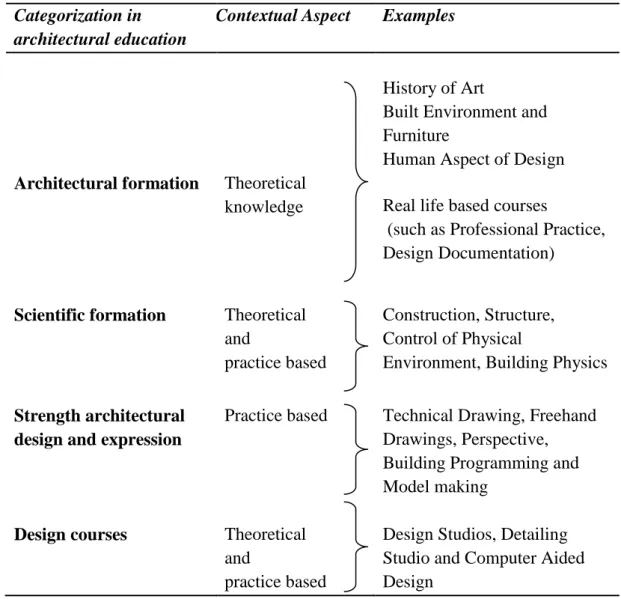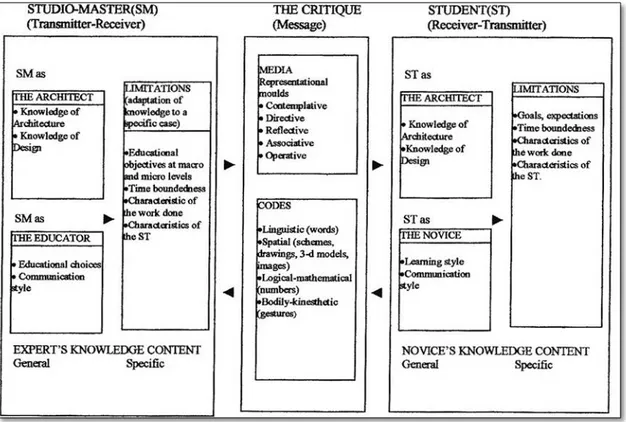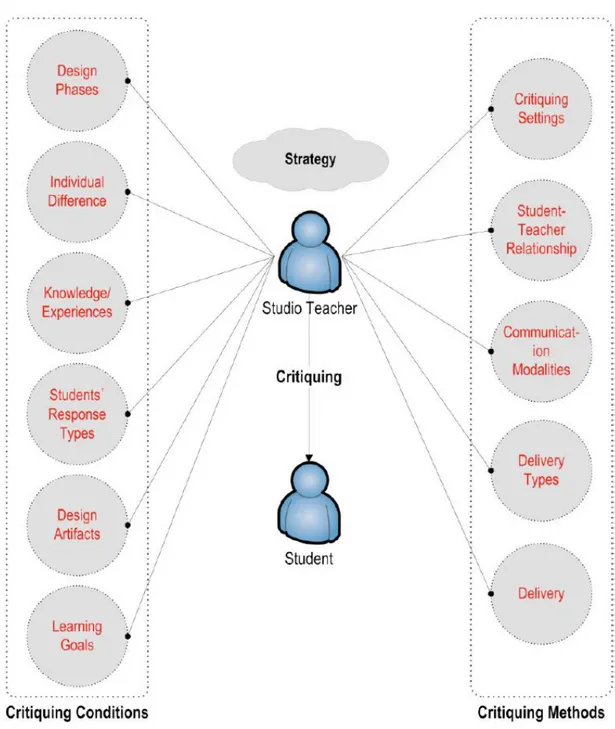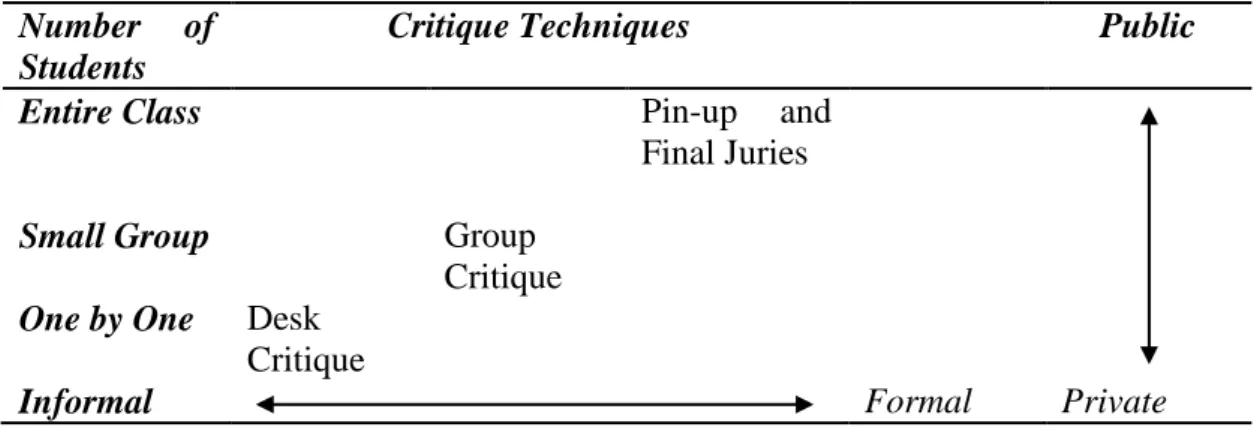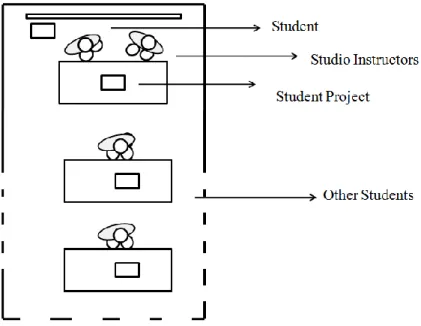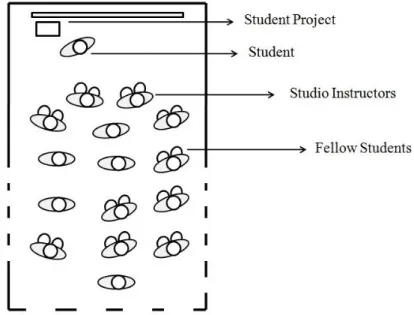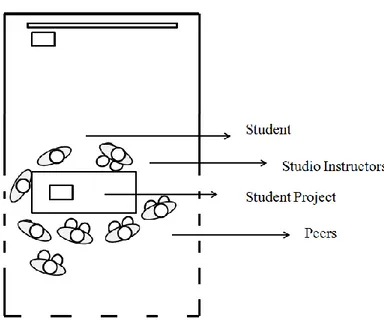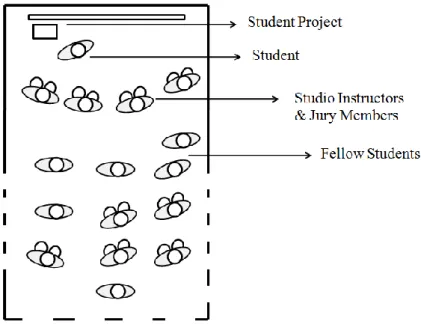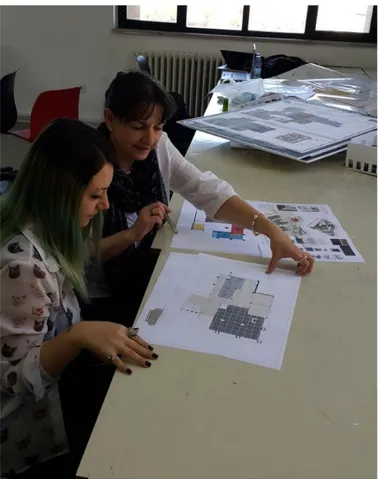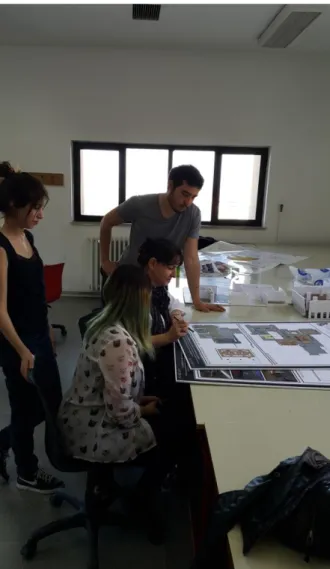ANALYZING THE EFFECTS OF
DIFFERENT CRITIQUE TECHNIQUES ON THE SUCCESS OF INTERIOR ARCHITECTURE STUDENTS
A Master's Thesis
by
ÇİLER GÖZDE GÜNDAY
Department of
Interior Architecture and Environmental Design İhsan Doğramacı Bilkent University
Ankara July 2015
ANALYZING THE EFFECTS OF
DIFFERENT CRITIQUE TECHNIQUES ON THE SUCCESS OF INTERIOR ARCHITECTURE STUDENTS
Graduate School of Economics and Social Sciences of
İhsan Doğramacı Bilkent University
by
ÇİLER GÖZDE GÜNDAY
In Partial Fulfillment of the Requirements for the Degree of MASTER OF FINE ARTS
in
THE DEPARTMENT OF
INTERIOR ARCHITECTURE AND ENVIRONMENTAL DESIGN İHSAN DOĞRAMACI BİLKENT UNIVERSITY
ANKARA
I certify that I have read this thesis and have found that it is fully adequate, in scope and in quality, as a thesis for the degree of Master of Arts in Interior Architecture and Environmental Design.
---
Assist. Prof. Dr. Yasemin Afacan Supervisor
I certify that I have read this thesis and have found that it is fully adequate, in scope and in quality, as a thesis for the degree of Master of Arts in Interior Architecture and Environmental Design.
--- Prof. Dr. Halime Demirkan Examining Committee Member
I certify that I have read this thesis and have found that it is fully adequate, in scope and in quality, as a thesis for the degree of Master of Arts in Interior Architecture and Environmental Design.
--- Prof. Dr. Mualla Erkılıç
Examining Committee Member
Approval of the Graduate School of Economics and Social Sciences
--- Prof. Dr. Erdal Erel Director
iii
ABSTRACT
ANALYZING THE EFFECTS OF
DIFFERENT CRITIQUE TECHNIQUES ON THE SUCCESS OF INTERIOR ARCHITECTURE STUDENTS
Günday, Çiler Gözde
M.F.A. in Interior Architecture and Environmental Design Supervisor: Assist. Prof. Dr. Yasemin Afacan
July 2015
This study presents the design education literature in terms of design studio learning by reviewing teaching styles, learning models and learning process. Additionally, the term critique is defined as a backbone of the learning process in design studios. The study focuses on three-critique techniques that are desk critiques, pin-up critiques and group critiques.
The purpose of this study is to analyze the effects of different critique techniques on the success of interior architecture students. It also explores correlations between student attitudes toward each critique technique and its contribution to the design process. A research was conducted with 3rd year interior architecture students in 2014- 2015 Fall Semester at Bilkent University. It was found that there was not a statistically significant
iv
relationship between student attitudes towards group, pin-up critiques and their final performance scores; however, there is a statistically significant relationship between student attitude toward desk critique and their final performance scores. Furthermore, the contribution of a critique technique to design process is highly correlated with student preference for this critique technique.
Keywords: architectural design education, design studios, critique techniques, desk critique, pin-up critique, group critique
v
ÖZET
FARKLI KRİTİK TİPLERİNİN
İÇ MİMARLIK ÖĞRENCİLERİNİN BAŞARISI ÜZERİNE ETKİSİNİN ANALİZ EDİLMESİ
Günday, Çiler Gözde
Yüksek Lisans, İç Mimarlık ve Çevre Tasarımı Bölümü Tez Yöneticisi: Yrd. Doç. Dr. Yasemin Afacan
Temmuz 2015
Bu çalışma, tasarım eğitim literatürünü birer öğrenme ortamı olan tasarım stüdyolarını öğretme stilleri, öğrenme modelleri ve öğrenme süreci açısından incelemiştir. Ek olarak, tasarım stüdyolarında kritik teriminin, öğrenme sürecinin belkemiği olduğu tanımlanmıştır. Bu çalışma, üç kritik tipine odaklanmıştır: masa başı kritikleri, ara dönem kritikleri (pin-up), grup kritikleri.
Bu tez, farklı kritik tiplerinin iç mimarlık öğrencilerinin başarısı üzerine etkisinin analiz edilmesini amaçlamıştır. Ek olarak bu tez, öğrencilerin kritik tiplerine olan tutumlarıyla, bu kritik tiplerinin tasarım sürecine etkisinin korelasyonunu incelemektedir. Bu
vi
araştırma Bilkent Üniversitesi 3. sınıf İç Mimarlık öğrencileriyle 2014- 2015 akademik güz döneminde yürütülmüştür. Araştırma sonucunda, öğrencilerin grup ve ara dönem kritiklerine karşı tutumlarıyla final notları arasında istatistiksel olarak bir ilişki saptanamamıştır; ama öğrencilerin masa başı kritiğe olan tutumlarıyla final notları arasında istatistiksel olarak bir ilişki saptanmıştır. Buna ek olarak, kritik tekniğinin tasarım sürecine katkısıyla öğrencilerin bu kritik tekniğini tercih etmeleri arasında yüksek bir korelasyon vardır.
Anahtar Sözcükler: mimari tasarım eğitimi, tasarım stüdyoları, kritik tekniği, masa başı kritik, ara dönem kritik, grup kritik
vii
ACKNOWLEDGEMENTS
Firstly, I would like to express my deepest gratitude to my supervisor, Assist. Prof. Dr. Yasemin Afacan, for her invaluable guidance, encouragement, patience and support. I would never be able to finish my dissertation without her guidance and support.
Secondly, I would also like to thank my committee members, Prof. Dr. Halime Demirkan and Prof. Dr. Mualla Erkılıç who allocated time to read my thesis and for their comments and constructive critiques. It is my duty to thank 2014- 2015 Fall Semester 3rd grade Design Studio students at the department of Interior Architecture and Environmental Design, Bilkent University. I also thank to all my dear friends Rengin, Fulden, Selin and Nilay for their helps, friendships and moral supports.
Moreover, very special thanks to my sister Özge and my mother Çiğdem who have supported me endlessly throughout this process. I am also grateful to my dearest and my husband Hasan Gül for helping me to initiate the process of master and for his endless encouragements. I would also like to thank my father Uğur Günday who not only encouraged me to study but also helped to make it happen.
viii
TABLE OF CONTENTS
ABSTRACT ... iii
ÖZET ... v
ACKNOWLEDGEMENTS ... vii
TABLE OF CONTENTS ... viii
LIST OF TABLES ... xi
LIST OF FIGURE...xiii
CHAPTER I ... 1
INTRODUCTION ... 1
1.1. Definition of the Problem ... 1
1.2. Thesis Objectives ... 3
1.3. Structure of the Thesis ... 4
CHAPTER II ... 6
LITERATURE REVIEW ... 6
2.1. Architectural Design Education ... 6
2.2. What is a Design Studio? ... 11
2.3. Learning Process in Design Studio ... 12
2.3.1. What is a Design Critique? ... 18
2.3.2. Teaching Style ... 20
ix
2.3.4.1. Desk Critique... 25
2.3.4.2. Pin-up Critique ... 26
2.3.4.3. Group Critique... 27
2.3.4.4. Other Critique Techniques ... 29
2.4. Student Attitudes toward Critique Techniques ... 30
CHAPTER III ... 33
CASE STUDY ... 33
3.1. Aim of the Study ... 33
3.1.1. Research Questions ... 33 3.1.2. Hypothesis ... 34 3.2. Methodology ... 34 3.2.1. Sample Group ... 36 3.2.2. Procedure ... 37 CHAPTER IV ... 41 RESULTS ... 41 4.1. Descriptive statistics ... 41
4.2. Student attitudes and success toward different critique techniques... 45
4.2.1. Group Critique ... 49
4.2.2. Pin-up Critique ... 50
4.2.3. Desk Critique ... 52
4.3. Correlations of students' attitudes and preferences for critique techniques ... 53
4.4. Students comment on different critique techniques ... 60
4.5. Discussion ... 63
CHAPTER V ... 66
CONCLUSION ... 66
x
APPENDIX A ... 78
A.1. Student personal information ... 79
A.2. Students' degrees of agreement ... 80
A.3. Student degrees of satisfaction ... 81
A.4. Student experiences on critic session ... 82
APPENDIX B ... 83
B.1. The Result of ANOVA for the difference between students categorization and their final grades ... 84
B.2. The Result of ANOVA for the difference between students categorization and their GPA ... 85
B.3. Group Statistics for the Statement 17 ... 86
B.4. One sample T test for the difference between genders for the Statement 17 ... 87
B.5. The result of Pearson Chi- Square test result for students attitudes towards group critique and their GPA... 88
B.6. The result of Pearson Chi- Square test result for students attitudes towards pin-up critique and their GPA ... 88
B.7. The Result of Pearson Chi- Square test result for students attitudes towards desk critique and their GPA... 90
xi
LIST OF TABLES
Table 1. Architectural design education categorization (Uluoğlu, 1990, Demirbaş, 2001) ... 7 Table 2. Criteria of learning (Adapted from Schunk, 1996, p.4) ...12 Table 3. Learning research paradigm (Adapted from Schunk, 1996, p.11) ...13 Table 4. Categories of representational forms of knowledge (Adapted from Sagun,
2003, p.46) ...16 Table 5. Critique setting considering (i) number of students, (ii) public- private
relationship, and (iii) informal formal (Adapted from Oh et al., 2013) ...25 Table 6. The point grades and the range of quality equivalents (YOK, 2015) ...39 Table 7. The letter grades and Quality point equivalents (Bilkent University, 25 May
2015) ...40 Table 8. Descriptive analyses of student categorization and GPA mean ...42 Table 9. Descriptive analyses of student categorization and final grades ...43 Table 10. Descriptive analyses of student categorization and previous semester final
grades ...44 Table 11. Analyses of Variance between final grades and students categorization ...44 Table 12. Analyses of Variance summary table between GPA and students
xii
Table 13. Means and standard deviations for students' satisfaction degrees of a desk critique ...47 Table 14. Cross tabulation between GPA ranges and highest mean attitude statement ...48 Table 15. Cross tabulation between GPA ranges and 'Prefer group critique rather than
desk critiques' ...48 Table 16. Cross Tabulation shows the relation between students' final grades and their
preference desk critic rather than pin- up critiques. ...49 Table 17. Cross tabulation between student attitudes toward group critique and GPA
range ...50 Table 18. Cross tabulation between students' attitudes toward pin-up critique and GPA
range ...51 Table 19. Cross tabulation between students' attitudes toward desk critique and GPA
range ...52 Table 20. Correlation matrix of students attitudes towards desk critique (Spearman's
rho, n= 84) ...55 Table 21. Correlation matrix of students' preference and these critique techniques
contribution to design process ...57 Table 22. Correlation matrix of students' satisfaction levels with desk critique ...59
xiii
LIST OF FIGURE
Figure 1. A model for studio master and student interaction in design studio (Uluoğlu, 2000,
p.38) ... 17
Figure 2. A Framework for Critiquing Practice: Conditions and Methods (Oh et. al., 2013, p.318). ... 23
Figure 3. Plan scheme of desk critique (drawn by the author, 2015) ... 26
Figure 4. Plan scheme of pin-up critique (drawn by the author, 2015) ... 27
Figure 5. Plan scheme of group critique (drawn by the author, 2015) ... 28
Figure 6. Plan scheme of final jury (drawn by the author, 2015) ... 30
Figure 7. The setting of desk critique (taken by the author, 2015) ... 35
Figure 8. The final jury (taken by the author, 2015) ... 35
1
CHAPTER I
INTRODUCTION
1.1. Definition of the Problem
Architecture design education is based on studio education and gaining fundamental knowledge on practical, social, cultural and technical subjects along studio education (Afacan, 2012). In the architectural design education, design studios are assumed as the core of the curriculum (Demirbaş, & Demirkan, 2003). In design studio, students are provided with the environment, where they gain knowledge and practice in their projects. According to Sagun, Demirkan and Göktepe (2001) design studios are defined as an environment that is different from a traditional classroom from pedagogical, sociological, ideological and epistemological points of view. Hence, the design studios can be handled in the view of developmental psychology of learning styles and "importance of design education, its' problems, relations and contents at sociological level and its relation to other disciplines at epistemological level" (Demirkan, & Demirbaş, 2003, p. 438). In the design studio, students can combine all the information that they have learnt in other courses. In other words, unlike a lecture course, students learn by applying the information to the studio projects and learn by doing in the design studios (Schön, 1987).
2
From this point of view, Shuell (1986) identified learning "as an enduring change in behavior or in the capacity to behave in a given fashion that result from practice or other forms of experience" (p.412). There are many different theories about how people learn. Burns (1995) conceives "learning as a relatively permanent change in behavior with behavior including both observable activity, and internal process such as thinking, attitudes and emotions" (p.66). According to Dunn (2002), there are six learning theories in design educational context, which are sensory stimulation theory, reinforcement theory, cognitive-Gestalt theory, holistic learning theory, facilitation theory, and experiential learning theory (2002, p.1).
Even there are theories of learning in the educational context; in design studios, there are two ways to use information learnt. The first one occurs through applying the information to the design studio project. The second one occurs in practicing. During this practice, design studio students initiate to learn by doing. Learning by doing is reviewed as experiential learning in literature (Schön, 1987). Kolb (1984) introduced experiential learning model and supposed that knowledge is gained through personal experiences (p.21). The experiences occur when students are individual while applying their knowledge to their design projects.
Nevertheless, students need to take feedbacks to apply their knowledge and being involved in their own design process. At this point, what is a critique and how is it conducted gain importance. In design studios, the critique process constitutes the backbone of the educational process. The literature defines critique as a tool of education in design studio. In other words, in a design studio for communication of
3
ideas and learning process, critique is a primitive step. For these reasons, critique techniques will be analyzed by exploring their effects to the success of the Interior Architecture students.
Briefly, design studios are the learning environments in architectural education and critique has an important role for transforming the design ideas. Additionally, each student's way of understanding of critiques and her/his attitudes toward different critique techniques, what s/he has experienced from the critique and how different critique techniques affects her/his success become key questions for design studios. However, there is a lack of information in literature in terms of critique types influences on student attitudes, experiences and success.
Thus, this thesis aims to find whether there are any statistical relationship between student attitudes toward different critique techniques and their final performance scores. It also explores statistical correlations between student attitudes toward desk, group and pin-up critique and their preferences.
1.2. Thesis Objectives
The main objective of this thesis is to analyze interior architecture students' attitudes, satisfaction degrees and experiences toward desk, pin-up and group critiques. The followings are the sub- objectives:
4
1. Identifying the effects of different critique techniques on the success of interior architecture students
2. Analyzing the relationship between student attitudes toward desk critique, pin- up critique and group critique
3. Identifying correlations between student attitudes toward critique techniques and contribution of these critique techniques to the design process
4. Analyzing statistical relationships between students' attitudes on different critique techniques and the final performance scores
5. Synthesizing literature review and case study statistical results based on student categorization and their preferences, learning experiences and satisfaction degrees
6. Suggesting further research on the related topic
1.3. Structure of the Thesis
This part provides an overview about each chapter. The second chapter, Literature Review, explores the literature on architectural design education, design studios, Schön's (1985) philosophy of design and design education is mentioned in this chapter. Design Studio are explained in detail. Teaching styles and learning models are elaborated. Goldschmidt's et al. (2010) categorization for the relationship between student and instructor is defined. Furthermore in this section, Schunk's (1996) criteria' is explained. In addition to the learning criteria, the history of a design critique and different critique techniques are presented. In the third chapter, Case Study, first methodology of the study, then research questions and hypotheses are presented. Finally, sample group and procedure are explained.
5
In the fourth chapter, the results of the case study are discussed based on the literature review. First, descriptive data of the sample group is presented in descriptive statics part. Then, each critique technique is analyzed separately in terms of its correlations to student attitudes, preferences and success. The differences between student categories are discussed in terms of student attitudes toward each critique technique. The quotations obtained from students' informal talks are also discussed. Briefly, the results of hypotheses, research questions and statistical findings (descriptive analysis, correlations, t-test results) findings are mentioned in this part.
The fifth chapter is conclusion of the study. Suggestions for further research are expressed in this chapter. References are stated in the following chapter.
6
CHAPTER II
LITERATURE REVIEW
2.1. Architectural Design Education
"Architecture is a multidisciplinary field that is a part of arts, sciences and social sciences" (Nicole, & Pilling, 2000, p.5). In architectural design education, the most significant part in the curriculum is design studios where students learn how to design. In design studios, students are expected to bring the knowledge from different disciplines to create design projects (Nicol, & Pilling, 2000).
According to Teymur (1992), the architecture department is considered as a part of arts, social and environmental studies, engineering in the academic consideration. Demirbaş (2001) defines architecture as a field of design or construction. According to Duffy (1995), it is better to define architecture as both professional practice and construction, because of the fact that the education of architecture is directly related with the professional practice.
7
On the other hand, Uluoğlu (1990) provides a general overview regarding the architectural design education. According to this overview, there are some courses that (1) develop the architectural formation, (2) present specific formation, (3) highlight strength of architectural design and expression and (4) teach all aspect of designing (Uluoğlu, 1990). Table 1 presents these courses related to the architectural design education.
Table 1. Architectural design education categorization (Uluoğlu, 1990, Demirbaş, 2001)
Categorization in architectural education
Contextual Aspect Examples
Architectural formation Theoretical knowledge
History of Art
Built Environment and Furniture
Human Aspect of Design Real life based courses
(such as Professional Practice, Design Documentation)
Scientific formation Theoretical and
practice based
Construction, Structure, Control of Physical
Environment, Building Physics
Strength architectural design and expression
Practice based Technical Drawing, Freehand
Drawings, Perspective, Building Programming and Model making
Design courses Theoretical
and
practice based
Design Studios, Detailing Studio and Computer Aided Design
8
Architectural design education that consists of studio teaching and project designing is the matter of synthesizing, evaluating, and presenting ideas regarding the solutions to common design problems (Afacan, 2012). In addition to this, architectural design education is also a context, which places an important emphasis on the oral communication proficiency (Dannels, 2005). According to Anthony (1991), oral communication assignments are the primary method in design studios, through which the performance of students is evaluated. The oral communication that is defined as critique has an important role in the architectural design education especially in design studios in terms of student performance.
However, before emphasizing the current terminology of architectural design education, the developments should be mentioned from past to present. In this respect, architectural design education is also defined as constructing and structuring creative opinions, thoughts, designing products through time with a definite addition of knowledge (Kahvecioğlu, 2007). According to Yürekli (2007), architecture is an academic field of study and research and architectural design education is durable by intellectual interest, energy and consciousness.
There are different kinds of definitive characteristics of architectural design education. Nevertheless, most of them point out the purpose of architectural education. Reviewing the literature shows that there are several aims of architectural design education. Kahvecioğlu (2001) states the aims of architectural design education: (1) to provide students with different design experiences, (2) to guide in taking an active role, (3) to take risks in different fields of disciplines, (4) to share the
9
knowledge, exchange and developments and (5) to express different cognitive approaches and scholar superiorities. According to these aims, in design studios, students have chance to deal with real design problems, which makes student practice architecturally. Moreover, each student also attends actively and get involved in the design process. Thus, design education provides students and instructors an interactive learning environment, where students share their knowledge and become part of the process. By interactive learning environments, it is meant that design education environment provides communication and motivation within the studio environment.
In the literature of architectural design education, Schön (1930-1997) is assumed as the influential theoretician of design and design education (Waks, 2001). Schön (1983) realized the rapid change in technology that threats people's individual and social identities. Schön (1983) also determined how generative metaphors consents people to build meaning in their consistently altering circumstances, combining older experiences to present through pointing similarities between them (Waks, 2001). These generative metaphors authorize people to take the familiar to tolerate in the unfamiliar in order to come out new concepts through preserving as well as of the old (Schön, 1963).
Schön (1983) also introduce to the concept of 'reflective practice'. Many education departments initiate improvements of their curriculums based on this theory. According to Schön (1983), reflective practice is a kind of ability that reflects on action occurring in the process of sustained learning. Subsequently, "the university
10
had become the epistemological center of practice and training ground for all practitioners" (Waks, 2001, p.39).
In the literature, there is some criticism on concept of ' reflective practice'. Kotzee (2012) points out the criticism in his work of 'private practice' and explores the missing social scope on 'reflective practice'. "Reflective practice is too individualistic in its conception of learning and that it leaves out the 'social dimension' of learning" (Kotzee, 2012, p.6). According to Kotzee (2012), Schöns' ideates practice as a kind of individualistic fashion.
Beside to Schön's philosophy, the retrospect of architectural design education has been gained an importance for understanding current architectural design education. At this point, Uluoğlu (1990) provides the information about the development of architectural design education. According to Uluoğlu (1990), in the first stage, there were no schools and professions were the masters. Then design theory was initiated to give some schools, however practice of design was missed. Nevertheless, with the need of both design theory and practice, the concept of design studio has begun, where theory and practice has met in an educational environment. Through this perspective, it can be said that design studios are the learning environments in architectural design education, which involves both theory and practice. As stated previously, both theoretical and practical aspects of design education have been developed through the oral communication.
11 2.2. What is a Design Studio?
The significant part of architectural design education takes place in design studios (Chaikin, 1998). Altay (2014) supposed that architectural and interior design education depend on design studios in which students meet with a design problem and solve this problem during the semester. According to Sagun (2003), design studios are the settings where students create projects; learn to improve their skills associated with projects. "In conventional design studio, students mostly work on the design brief individually and learn the design process as an individual activity" (Sagun, 2003, p.39). According to Cuff (1991), design studio is a educational setting like not solely working place, but also as an arrangement of home and working place like "contemporary concept of home office" (p. 219). This is because, architecture students spend their most of the time in design studios and they should perceive the design studio where they may study both during and after the class hours (Gur, 2010).
In traditional design studios, learning and teaching design occur in individual working settings like a drawing desk and each student has his or her own drawing desk (Sagun, 2003). Students and instructors meet and interact face to face in these settings to discuss projects. In some cases, there might be more than one student and each student have chance to get involved with each other's teaching and learning process. "Although discussions are held among students, design is explored as an individual activity" (Sagun, 2003, p.37). The alternative solutions for design projects are taking place in design studios. The participation of students in design studio occurs while they are introducing their own solutions for same design problem. In
12
that sense, students may have chance to observe, analyze and discuss each other's design projects (Sagun, 2003). Design studios are ordered through associating with the assets and activities occurring in the studio (Sagun, 2003).
2.3. Learning Process in Design Studio
In the literature, there is not only one description of learning. However, Schunk (1996) provides three criteria that help to define a learning model (Table 2). The first criterion is that one can learn when s/he becomes able of performing something differently. According to this, "learning is based on what people say, write and do" (Schunk, 1996, p.4). The second criterion supports that something that is learnt may not be remembered by people due to some factors like fatigue, alcohol etc (Schunk, 1996). The third criterion is about learning by doing. Schunk (1996) supports that learning can occur through practice, observation and experiences.
Table 2. Criteria of learning (Adapted from Schunk, 1996, p.4)
Three criteria Definition
Learning involves change Learning endures overtime
Learning occurs through experience
Learning is based on what people say, write and do Learning may not last forever because forgetting occurs
Like practice, observation of others
Schunk (1996) also mentions a learning research paradigm, which involves correlation to examine relation between variables, experimental research when one or more variables are altered, a qualitative research in the case of description of events,
13
laboratory for projects could be conducted in a controlled settings and finally the field survey when projects are conducted in a natural setting (Table 3).
Table 3. Learning research paradigm (Adapted from Schunk, 1996, p.11)
Methods Definitions
Correlation Examines relations between variables Experimental One or more variables are changed Qualitative Concerned with description of events Laboratory Project conducted in a controlled setting
Field Projects conducted a natural setting
In addition to Schunks' criterion, Kelly (1997) negotiates the learning, which is created by Saljo (1979). According to Kelly (1997), Saljo claims learning as an activity and came up with a cascade list of learning. As far as Saljo (1979) is concerned, (i) learning enhances knowledge, (ii) learning is memorizing, (iii) learning is improving abilities and techniques, also gaining facts, which may be utilized as needed, (iv) learning is regarded as having merit of information, distilling the meaning and combining the information to daily life, (v) learning is related to accepting the world through reinterpreting knowledge. Depending on this classification, whereas first third step is more external, last two steps are internal. In other words, through depending on last two-step of this classification, learning is a process that depends on the experimentation. Briefly, people agree that learning is
14
significant; however, they have varied sights on the stages and results of learning (Schunk, 1996).
Besides the definition of learning and classification about learning, how learning process is defined in design studio is also significant. "Design studio is characterized by a teaching model that is distinctly suited for problem- solving" (Maturana, 2014). According to Ledewitz (1985), there are three aspects of design education in terms of teaching: (i) learning and practice, (ii) learning new language, (iii) learning thinking architecturally. Firstly, in design studios, students learn and practice a number of new skills. Secondly, students learn a new language in design studio as well (1985). At this point Ledewitz (1985) mentions Schön's (1992) description of design 'graphic and verbal language game', in which drawing and talking are supplementary and intimately linked. As a third aspect, Ledewitz (1985) supports that "in design studio, students learn 'thinking architecturally' referring to 'particular domain of problems and solutions that characterize, and are fundamental to professional performance" (p.2).
The educational process in design studio involves not solely teach all three aspects but also learning them at the same time (Ledewitz, 1985). To illustrate, drawing is a tool for communicating 'spatial concepts'. In addition to Ledewitz (1985) narrative of design studio, Demirbaş and Demirkan (2003) support that organization of essential knowledge and representation of this knowledge is significant issues in design studios. Sagun (2003) claims that the process in the design studio occurs with identifying design brief and introducing the design problem as well as introducing
15
the qualifications of the problem set. At this point, students explore the current problem through discussions. The expectations are drawn clearly and throughout the semester student and instructor comes together through informal and formal meetings (Sagun, 2003).
The learning process in design studio also involves teaching how to design architecturally, including the progress of students' creativity and their critical thinking on design problems (Spridonidis, & Voyatzaki, 1998). Designing aspects come along with the term of design knowledge in the literature. "The content of design knowledge is based on the design process" (Sagun, 2003, p.46). Uluoğlu (2000) described the process of design knowledge under four headings: categories, structuring, representation and content.
According to Sagun (2003), the knowledge category occurs in the process of conceptualization. Act of structuring knowledge occurs through analysis of design development and pointing the strong and weak aspects of students' projects. The third one, representation is knowledge in which reflective knowledge, operative knowledge, contemplative knowledge, directive knowledge, associative knowledge and other informal communication issues are mentioned (Table 4). According to reflective knowledge, interpretations and descriptions are stated whereas in the operative knowledge, coaching and demonstrations are stated (Sagun, 2003). Contemplative knowledge involves questions, reminders and problem statements whereas directive knowledge includes completions, conflictions, positive and negative statements (Sagun, 2003). The final representation of knowledge, associative knowledge involves examples, analogues and scenarios (Sagun, 2003).
16
The last category, content occurs through the conceptual structure and depends on quantitative and qualitative characteristics (Sagun, 2003). What it means is that quantitative knowledge occurs through conceptual developments whereas qualitative part of knowledge occurs through meaning of concept and the relationship between other concepts (Sagun, 2003).
Table 4. Categories of representational forms of knowledge (Adapted from Sagun, 2003, p.46)
Representation
of knowledge What they involve
Reflective knowledge Interpretations and description Operative knowledge Coaching and demonstrations
Contemplative knowledge Questions, reminders and problem statements
Directive knowledge Completions, conflictions, positive & negative statements
Associative knowledge Examples, analogies and scenarios
Moreover, According to Uluoğlu (2000), knowledge has two parts: (i) knowledge for being good architect/ designer, (ii) knowledge for being good educator. Uluoğlu (2000) states that being a good architect is not enough for being studio master and teaching design necessitates different skills than designing. In Figure 1, Uluoğlu (2000) provides the process of interaction between instructor (SM) and students (ST).
17
Figure 1. A model for studio master and student interaction in design studio (Uluoğlu, 2000, p.38)
The learning process in design studio does not solely involve teaching Ledewitz's (1985) three aspect and above mentioned categories but also learning them at the same time. To give an example, drawing is a tool for communicating spatial concepts. In addition to Ledewitz's (1985) narrative of design studio, Demirbaş and Demirkan (2003) support that organization of essential knowledge and representation of this knowledge is significant issue in design studios. The learning process in the design studio occurs with identifying design brief and introducing the design problem as well as introducing the qualifications of the problem set. At this point, students explore the current problem through a number of discussions throughout the semester, during which student and instructor come together with informal and
18
formal meetings (Sagun, 2003). In the next subsection, these discussions are mentioned in detail under the terminology of design critique.
2.3.1. What is a Design Critique?
Critique is "a detailed analysis and assessment of something" ("Critique", 2015). According to Silverman (1992), critique is an action that identifies problems and user based solutions through judgments. Besides the dictionary definition, Ostermann (1998) explains critique as an advice, suggestions and questions regarding the project, which is about individual student presentations on their own project.
Fischer et al. (1998) define critique as a dialog, which enhances the knowledge regarding the design situations. According to Fischer et. al. (1998), the process of critique involves supporting incorporation of design problem identification and solving. It also helps to access related issues in the information space through emphasizing problematical situations and improving arguments related to the design solutions occurs (Fischer et. al., 1998). Schön (1985) describes what design knowledge is conveyed during a design critique session using the concept of 'repertoire', which is a collection of descriptions, thoughts, actions and illustration.
Schön (1983) conceptualizes the design critique as reflective and communicative coactions with the material and object of a design situation. The process of interaction occurs between students and instructors and this process is called as critique in design studio (Dannels, 2005). Schön (1985) called this process as
19
'reflection in action'. To understand the concept of reflection in action, it is significant to understand how reflection is occurs. Reflection is significant in learning from experiences and allows students to figure out the relationship between theory and practice (Gray, 2001).
According to Schön (1987), during the critique process, there are two ways for interaction: (i) telling and listening and (ii) representation and imitating. By saying telling and listening, the significant point is to mention the necessary precepts to the student (Demirbaş, 2001). According to Demirbaş (2001), design studio and out of studio is similar that means students, who have difficulty in anything in the outer world, may have difficulty in the studio. However, the difference is that student may learn the essential information to conquer the complexities in the studio (Demirbaş, 2001).
The first way for interaction, telling and saying, is not a single way of interaction that is constant and mutual action between studio instructors and students (Demirbaş, 2001). This is mutual and constant, because while instructor tells, student listens and then student initiate to create some solutions for a design problem in design studio and while student tells solutions for his/ her design problems, studio master listens and become listener (Demirbaş, 2001). In the representation and imitating, Demirbaş (2001) supposes that studio master presents components or characteristics of designing to assist student comprehensions through believing "students need to learn and in doing so, attributes to students capacity for imitating" (p. 24). Following this process, students may form the diversification of that action. Observation of that
20
action is such problems solve and through altering an imitating action, student may find out new clarifications (Demirbaş, 2001).
The design critiquing has always been a hearth of the education and for this reason, firstly students should understand the critiques, and second, critique should conceive a message through the knowledge of studio master (Uluoğlu, 2000). Nevertheless, there are some factors that may affect design critiquing (Oh et al., 2013). In the following subsection, teaching styles are mentioned as a factor of design critiquing.
2.3.2. Teaching Style
Besides the learning process in a design studio, teaching styles should be also mentioned as a factor of this learning environment. "A teaching style may be described as a plan of action, which defines the attitudes of instructor and the learner for the purpose of complete objectives in subject matter and actions" (Ashworth, 1998, p.120). Studio master's role as an instructor may be altered through their instructive choices and communication techniques (Uluoğlu, 2000). All instructors may have different strategies while communicating with students. Some instructors prefer telling whereas others demonstrating and most of them prefer both (Demirbaş, & Demirkan, 2003).
As Uluoğlu (2000) mentions, teaching of design have not a specific way. However, it may alter through the interaction with the design student and instructor. Goldschmidt et. al. (2010) provide categorization of the interaction between instructor and student.
21
According to Goldschmidt and colleagues (2010), there are three types of interaction that are (1) master and apprentice, (2) user and designer, (3) peer critique between studio instructors and students. Oh et al. (2013) identifies Goldschmidt's, Hochmans', and Dafnis' work (2010) through the categorization of the relationship between student and instructor. The first one is master and apprentice relationship, in which instructor play a role of master and students play a role of apprentice (p.309). The second relationship is user and designer, in which the instructor become a user, who comments on the project from the user perspective (Dutton, 1991). Moreover, according to Oh et al. (2013), even though it is not possible to eliminate the teachers role as an professional, user- designer relationship provides "a less intimating, more constructive learning environment" (p. 310). The third categorization is peer critique, which occurs in the group critique or informal discussions. This enables students to involve more actively in discussion, where collaborative learning environment occurs (Oh et al., 2013). Briefly, the interaction between student and instructor plays an important role during the critique and has different forms depending on instructor or student relationship.
Furthermore, the literature of architectural design education involves a methodological model of critique sessions and some factors that structure critiques. These factors emphasize the design instructors to figure out most beneficial critique techniques. There are two main conditions related with the critiquing. The first critique condition is related with the settings like desk, group or pin-up critiques, communication modalities like speech, drawing or gesture, delivery types like facilitative or directive, and the last one is related with the delivery itself that is about instructors linguistics and modality choices (Oh et. al., 2013 p.76). The second
22
condition is related with design phases, individual differences, knowledge and experiences, students' responses, design artifact and learning goals (Table 2.3).
According to Oh (2010), there are five steps for instruction during the critique: (1) observation, (2) noticing, (3) identification, (4) sequence and (5) delivery. Observation occurs when instructor listens and observes student design presentation on the model or sketches (Oh, 2010). When instructor perceives a problematic design issue in students work, noticing occurs. Based on this problematic situation, the instructor identifies the issue and its reasons, possible solutions are drawn, and this step is the identification (Oh, 2010). In addition, sequence occurs when instructor arranges where to deliver feedback to the student (Oh, 2010). To illustrate, instructor may prefer to initiate critique through positive aspects of students design. "Finally, instructor delivers the critique" (Oh, 2010, p.56). According to Torrey (2009), in this step, instructors' linguistics and approach gain significance. Briefly, instructor's gestures, facial expressions and the height of voices have an influence on the interaction between instructor and student and affect the critique.
These factors and critiquing methods are significant for instructors to choose the best strategy to give critiques a student. This may be significant to develop a proper and rigorous pedagogy for the design education and to provide a framework for critiquing practice with studio teachers. Figure 2 illustrates these relationships among studio teacher, student and critiquing. Through basing on students learning process and the interaction process between instructors and students, critique techniques in design studio are mentioned in following subsection.
23
Figure 2. A Framework for Critiquing Practice: Conditions and Methods (Oh et. al., 2013, p.318).
24 2.3.4. Techniques of Critique Session
In the design studio, student awareness regarding the design situation are improved through critique process by figuring out the challenging conditions (Demirbaş, 2001). Design education researchers mentions several techniques of critique that instructor uses to communicate with students (Oh, 2010). Bailey (2004) comes up with desk critiques, group critiques, interim reviews (pin-up critiques), final reviews and informal interactions. For this study, three of them gain importance that are desk, interim (pin-up) and group critiques. A brief description of these three critique techniques are given in the following subsection.
Before the deepest information regarding the critique techniques, Table 5 illustrates how a critique is categorized. Firstly, a critique technique can be characterized through the number of students. Secondly, it is identified through the range between private and public. Even design studios are open environments, desk critiques are more private compared to group and pin-up critique techniques. However, according to Cuff (1991), design studios are the open spaces and students as expected observe each other's development, comment informally their peers' solutions for design problems, compare design development, and/ or learn certain skills such as drawing and modeling. What it means that it is not extraordinary for students to support from overhearing other students' desk critiques (Oh et. al., 2013).
25
Table 5. Critique setting considering (i) number of students, (ii) public- private relationship, and (iii) informal formal (Adapted from Oh et al., 2013)
Number of Students
Critique Techniques Public Entire Class Pin-up and
Final Juries
Small Group Group Critique
One by One Desk Critique
Informal Formal Private
2.3.4.1. Desk Critique
"Desk critiques take place throughout the entire semester (typically 12- 16 weeks) of a studio course" (Oh, 2010, p.58). This type of critique provides students with an understanding of the process from the instructor perspective (Oh et. al., 2013). According to Dannels (2005), desk critiques are the oral presentations that are between instructor and a student and are structured as informal. Nevertheless, based on the relationship between students and instructors, students have different abilities to benefit from the critique and develop it as a feedback. Schön (1985) considers desk critique as a significant element of studio teaching. In addition to this, desk critique is the most effective critique technique in design studio, since instructors have chance to see the progress of each student in desk critiques more in detail (Koch et al., 2002). In addition to this, Goldschdmidt (2002) find out how a desk critique provides student and instructor detailed critical design knowledge. Alternatively, Dannels (2005) provides oral genre analysis of critique techniques in design studio by using interviewing and observation techniques. According to Dannels (2005), desk critiques are the most informal of the oral genre in design studios and in desk
26
critiques, instructors spends significant time for each students. Instructor may work with students one by one and give each students direction (Dannels, 2005). One of the faculty members that Dannels had interview defined desk critique as follows:
"There is a studio where students spend three days a week and the faculty member assumes the role of the master and goes around from desk to desk, explaining to the students what's right and what's wrong with their work. That is the desk critique" (Dannels, 2005, p.144).
Figure 3. Plan scheme of desk critique (drawn by the author, 2015)
2.3.4.2. Pin-up Critique
In addition to desk critiques, interim (pin-up) gives chance to students to develop the projects (Oh et. al., 2013). According to Dannels (2005), pin-up critiques are the oral representations that students have chance to display their tools on a large wall and get the comments. In some cases, pin-up may be more public and students have chance to get feedback from both instructors and other students (Oh, 2010). In here
27
students explains what s/he has done and instructor shares the ideas about what they see and perceive (Dannels, 2005). Furthermore, pin-up juries are less informal compared to final juries and the evaluation is not aimed. For this reasons, the comments are more constructive than evaluation (Anthony, & Bailey, 2004). According to a faculty member, that Dannels (2005) had interview in his work:
"The pin up is where we pull the drawings off the desk you're currently working on, smack them up on the wall and look at them in a question and answer way, you tell me, then I respond back to you, until the whole class gets a sense of this is where we are" (Dannels, 2005, p. 144).
Figure 4. Plan scheme of pin-up critique (drawn by the author, 2015)
2.3.4.3. Group Critique
Even there is confusion in the literature about group critique; this study defines group critique as a critique technique where instructors and students discuss presented works of each student while being gathered around a desk (Oh et. al., 2013).
In-28
group critique, each student has also chance to listen and see the development process of other students (Oh et. al., 2013). On the other hand, Farivarsadri (2001) claims that group critiques are beneficial at the beginning of design semester and initiation of the design projects, since in the initiation of the projects, all students are trying to figure out possible design solutions and through group critiques each students may have chance to see each other's possible solutions. Since it is a informal setting, students who have a lack of confidence to speak in front of public, have chance to participate actively to critique and have chance to produce more solutions to the same design problems (Farivarsadri, 2001). With the help of group critiques, students could develop their design ideas by actively involving in the comments of other project solutions (Sagun, 2003).
29 2.3.4.4. Other Critique Techniques
Even for this thesis, three critique techniques are taken into consideration there are other critique techniques that are applied during different stages of architectural design process. To give an example, final critiques are the final stage of a design problem and provide students an expert perspective.
Students are generally preparing large panel in which they organize drawings expressing their design (Oh, 2010). Because it is a formal review, according to Argyris (1981), there is a syndrome called as 'mystery/ mastery syndrome' referring to using complicated words emitting an atmosphere of mystery for demonstrating mastery of architectural knowledge. According to Oh (2010), this syndrome may derange students through making them complicated to comprehend professionals' comments and discussions. Dinham (1986) provides the following suggestions for formal (final) review:
(1) Students may be educated by evaluating and discussing about their projects in the final jury.
(2) Final juries are aimed to educate all the students at the same time in the design studios. For instance, while jury member comments on student work, the discussion on common concern occurs. In other words, students have chance to learn their missed parts from their classmates design.
(3) Since in the final juries, there are generally guests from professional architects. This provides students hearing challenging conversations regarding the subject.
30
Figure 6. Plan scheme of final jury (drawn by the author, 2015)
Consequently, critique has a crucial role in the design studio. However, before deciding the best and beneficial critique type for the architectural design education process, student attitudes towards critiques should be also defined. Additionally, in different educational levels, different techniques of critiques could be preferred. The parameters of the given design problem, student education level, stages of design process are main factors that play a significant role in the decision of critique types (Oh et al., 2013).
2.4. Student Attitudes toward Critique Techniques
Within the framework of the study, the definition of the attitude term is based on the social psychology definition, which is figuring to individual's straightforward preferences (Allport, 1935). In the educational aspect, attitude is defined as tendency to reply positively or negatively to definite objectives (Martino, 2009). For this
31
thesis, attitude is accepted as student's standpoints and preferences through different critique techniques in design studios. In design studio, student attitudes toward critique techniques are significant. For architecture students, attitudes also means being qualified for studying architecture, and being an architect having own specific characters like, ability to communicate. According to Rohrbach (2005), design instructors may have a lack understanding of the restructure their teaching methods especially their critique methods with respect to student attitudes. Student attitudes toward a critique are also significant in term of interaction between instructor and students. Based on student complains and suggestions, instructors could improve their teaching and learning models to increase student abilities of understanding given feedback.
However, before moving student attitudes toward critique techniques, students' general attitudes in design studio should be mentioned. What Bakarman (2011) supposes is that students in design studio should have aptitude to produce several alternatives for progress their design knowledge whereas they understand of design problem. This is because, according to Lawson (1997), students should be 'solution- focused' not 'problem- focused' while they handle the design problems. According to Bakarman (2011), student attitudes may be shaped by the amount of experiences that they gain in design studio. Based on student experiences, a design student has to gather the professional attitudes like having professional performance while handling the design problem, managing time, gaining knowledge and controlling them (Bakarman, 2011). Additionally, Cross (2006) listed student attitudes and aptitudes in design studio as follows:
32
(i) The aptitude for collecting the related information engage in design problem,
(ii) The aptitude for gaining experiences, since studio masters' aptitude is based on the amount of experiences that student gains,
(iii) Students have attitude of figuring out most of design problems and utilize the significant parts of them,
(iv) Student attitudes toward design problem should have to be solution- oriented,
(v) Students bargains with peers, and other studio members.
Some students could understand and apply the given critique in much better way whereas others have difficulty. Since a critique is an interaction between student and instructor, student response is important. To categorize student attitudes toward different critique techniques, Kent (2001) categorized the students as follows: (1) thinkers, (2) listeners, (3) skeptics, (4) misunderstanders, (5) followers, and the (6) affirmed ones. Thinkers reflect what they hear from instructor and try to combine their ideas and instructor feedback on their design. Listeners understand the instructor feedback; however, they cannot come with an applied design. Skeptics are skeptical regarding instructor ideas and have tendency to discount the feedback they receive. Students who misunderstand instructor comments and apply what they want to hear. Followers remember and apply instructor critiques concretely. Finally, the affirmed one assumes that instructor has the same idea with their ideas (Kent, 2001). This study also used Kent's (2001) categorization and analyzed the correlations between the critique techniques and student categories.
33 CHAPTER III
CASE STUDY
3.1. Aim of the Study
The main aim of this thesis is to find out the statistical relationship between student attitudes toward different critique techniques and their final performance scores. It is aimed to explore statistical correlations between student attitudes toward desk, group and pin-up critique and their preferences. This study also aims to find out whether there is any correlation between student positive attitudes toward critique techniques and these critique techniques contribution to design education process.
3.1.1. Research Questions
The research questions of this thesis are as follows:
1) Is there any statistically significant relationship among different critique techniques in terms of student preference? (i. group and pin-up critiques, ii. desk and group critiques, iii. pin-up and desk critiques)
2) How student attitudes towards different critique techniques are correlated with each other?
34 3.1.2. Hypothesis
The hypotheses of this thesis are as follows:
H1: There is a statistically significant relationship between student attitudes toward different critique techniques and their GPA.
H2: The contribution of a critique technique to design education process is highly correlated with student preference for this critique technique.
3.2. Methodology
Figure 7 emphasizes the settings of desk critique. The mediums are sketches, ortographic drawings, 3D models. The instructor and a student are sitting near a drawing desk and they interact with each other. Figure 8 also presents an exemplary final jury situation, in which a student pin up his drawings on wall, and instructors and the other students listen his representation of the project solution. The setting of the final jury is similar with pin-up critiques. However, during pin-up critiques, generally, two design studio instructors, who had already know student’s process, listen to project representation, and there are more students listen to the pin-up critique. Figure 9 depicts an exemplary group critique session, in which instructor and students stand or sit near a desk.
35
Figure 7. The setting of desk critique (taken by the author, 2015)
36
Figure 9. The group critique (taken by the author, 2015)
3.2.1. Sample Group
In order to analyze the effects of different critique techniques on student attitudes, experiences and success, 3rd grade Interior Architecture and Environmental Design
students at Bilkent University are chosen from the 2014- 2015 Fall Semester. There are three sections and each section has 30 students. 84 out of 90 students are participated to the survey. The reasons of why 3rd grade students are selected are as follows:
37
(1) Because of the complexity of the projects, 3rd year design studio requires different critique techniques.
(2) Third year students start to transform the knowledge gained from other courses and initiate to solve spatial problems more in detail.
(3) Third year students are more familiar with different critique techniques compared to 1st and 2nd year students.
3.2.2. Procedure
A survey, which is composed of four parts, is conducted. In the first part, the author collected data related to students demographics, such as name, gender, previous semester design grades and student GPAs. In this part, students have also chosen one of the six student categories that are thinkers, listeners, misunderstanders, skeptics, followers and affirmed ones that they find close to themselves during the critique in design studios (See Appendix A.1).
In the second part, student attitudes toward different critique techniques are explored through the five point Likert scales (5 for 'Strongly Agree' and 1 for 'Strongly Disagree') (See Appendix A.2). In total, there are 25 statements and eight of them about group critique, nine of them related with pin-up critique and eight of them related with desk critique. In the third part, five point Likert scales (5 for 'Very Satisfied' and 1 for 'Very Dissatisfied') are used with 21 statements 7 for each critique techniques that concentrate on student satisfaction degrees toward different critique techniques (See Appendix A.3). Last part includes open-ended questions,
38
where students have chance to share their own ideas regarding each critique technique and some further suggestions (See Appendix A.4). According to Cronbach's Alpha, the reliability of the survey is 0.926.
This survey was held on 22, 23 December in 2014-2015 Fall Semester. The results of the survey are analyzed both quantitatively and qualitatively. Quantitative data analysis is done with the Statistical Package for the Social Sciences 20 (SPSS). The statistical calculations, descriptive statics, chi- square, t-test and correlation matrices are used. The statistical data is discussed in three parts. In the first part, descriptive statistics involves descriptive tables according to the number of participants, their gender, design grades and GPAs. In this part, student responses to the satisfaction degrees are also analyzed through descriptive analyses. To figure out student categorization and its relation with students' success, t-test is conducted in this part.
In the second part, correlation analysis is used to identify the correlations between critique techniques and student attitudes toward these critique techniques. The correlation matrices are calculated to identify associations between attitude items. The relationship between items are stated in terms correlation coefficients i.e. between 0.9 and 1.0 indicates very highly correlation between two variables whereas between 0.5 and 0.7 indicates moderately correlation and between 0.3 and 0.5 indicates a low correlation (Argyrous, 2005). In the third part, student experiences and views are shared in the form of direct quotations.
39
The grading system of Bilkent University is used while analyzing the results (Grading and Grade Point Average, 25 May 2015). Bilkent University uses letter-grading scheme with plusses and minuses showed in Table 6. Considering this system, 'A+' is the highest grade, pointed 100 whereas F is the lowest grade pointed between 0- 49. Between A+ to D grades are passing for design studios and below 'F' is failing grade. In this study, 'A' to 'C' is called as successful whereas below 'C' is unsuccessful. In terms of GPA ranges, 2.00 to 2.99 are called as successful whereas 3.00 to 3.49 are honor and 3.50 to 4.00 are high honor degree.
Table 6. The point grades and the range of quality equivalents (YOK, 2015)
Point Quality point equivalents
100 4.00 96-100 3.70- 4.00 91-95 3.58- 3.69 86-90 3.36- 3.57 81-85 3.19- 3.35 76-80 2.93- 3.18 71-75 2.72- 2.92 66-70 2.50- 2.71 61-65 2.33- 2.49 56-60 2.12- 2.32 50-55 1.86- 2.11 0- 49 1.00-1.85
40
Table 7. The letter grades and Quality point equivalents (Bilkent University, 25 May 2015)
Letter Grade Quality point equivalents
A+ 4.00 A 4.00 A- 3.70 B+ 3.30 B 3.00 B- 2.70 C+ 2.30 C 2.00 C- 1.70 D+ 1.30 D 1.00 F 0.00 FX 0.00 FZ 0.00
41
CHAPTER IV
RESULTS
4.1. Descriptive statistics
Descriptive statistics aims to categorize and describe the data through showing relationships between the variables (Boxill, Chamber & Wind, 1997). In this part, it is aimed to mention the general descriptive of 3rd grade Interior Architecture and Environmental Design students at Bilkent University.
According to the results, there are 68 female students and 16 male students attending the survey. The mean of their previous semester design grade is 80, fitted B in letter grade. The mean of 2014-2015 Fall Semester final design jury grade is 77, fitted B- in the letter system. Besides the design grades, students' Grade Point Average (GPA) are also asked and the mean of GPA is 2.50 out of 4.00. In terms of gender distribution, the mean of female GPAs is 2.46 whereas the mean of male GPAs is 2.66.
As it is mentioned in the literature review, there are six types of students that are (1) thinkers, (2) listeners, (3) skeptics, (4) misunderstanders, (5) followers, and the (6)
